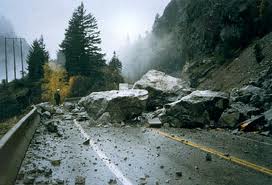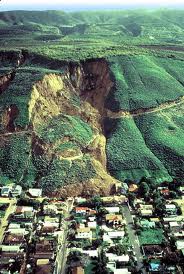Ch 5 Unit 3 Honors Quiz Mass Movements

This Quiz will cover the concepts covered in Unit 3 Mass Movements.
- 1.
Identify this form of Weathering
- A.
Physical
- B.
Chemical
- C.
Biological
Correct Answer
B. ChemicalExplanation
Chemical weathering is the process by which rocks and minerals are broken down through chemical reactions. This form of weathering involves the alteration of the chemical composition of the rocks, leading to their decomposition or dissolution. It is caused by various factors such as water, acids, oxygen, and other chemicals present in the environment. Chemical weathering can result in the formation of new minerals, the weakening of rocks, and the erosion of landscapes.Rate this question:
-
- 2.
________________, the slowest type of mass movement, involves the lifting and contracting of soil particles over time.
Correct Answer
creepExplanation
Creep is the slowest type of mass movement that occurs when soil particles are lifted and contracted over time. This gradual movement is usually caused by the expansion and contraction of soil due to freeze-thaw cycles or wet-dry cycles. Creep often happens on slopes and hillsides, where gravity slowly pulls the soil downhill. The movement is so slow that it is often difficult to detect, but over time, it can cause significant changes in the landscape.Rate this question:
- 3.
Identify this type of mass movement
- A.
Creep
- B.
Landslide
- C.
Mudflow
Correct Answer
C. MudflowExplanation
A mudflow is a type of mass movement where a mixture of water, soil, and rock flows downhill due to gravity. It occurs when heavy rainfall or melting snow saturates the ground, causing the soil to become unstable and flow like a liquid. Mudflows are common in areas with steep slopes and loose, unconsolidated soil or sediment. They can be extremely destructive, carrying large amounts of debris and causing significant damage to structures and infrastructure in their path.Rate this question:
-
- 4.
One of the most dramatic triggers of sudden mass movements is a(n) ___________________ .
Correct Answer
earthquake
earth quake
earthquakesExplanation
An earthquake is a sudden and violent shaking of the ground, often caused by the movement of tectonic plates beneath the Earth's surface. This movement can cause the ground to shift and destabilize, leading to sudden mass movements such as landslides, avalanches, or rockfalls. The energy released during an earthquake can have a significant impact on the stability of slopes and can trigger these mass movements, making it one of the most dramatic triggers for such events.Rate this question:
- 5.
One trigger of mass movements occurs when the pores in sediments become filled with _____________________.
Correct Answer
water
H20
liquidExplanation
Mass movements, such as landslides, can be triggered when the pores in sediments become filled with water. Water acts as a lubricant, reducing the friction between particles and making the sediment more prone to movement. Additionally, when sediments become saturated with water, their cohesion is weakened, further increasing the likelihood of mass movement. Therefore, the presence of water, whether in the form of H20 or as a liquid, is a key factor in triggering these events.Rate this question:
- 6.
The force that drives mass movements is _______________________ .
Correct Answer
gravityExplanation
Gravity is the force that drives mass movements. Gravity is a fundamental force of nature that attracts objects towards each other. In the context of mass movements, gravity pulls objects or masses downhill, causing them to move. This force is responsible for various types of mass movements, such as landslides, rockfalls, and avalanches. The gravitational force acting on the mass, combined with factors such as slope steepness and material properties, determines the intensity and speed of the movement. Therefore, gravity is the primary force behind mass movements.Rate this question:
- 7.
Identify this form of Mass Movement
- A.
Creep
- B.
Rockfall
- C.
Landslide
Correct Answer
B. RockfallExplanation
Rockfall is a form of mass movement where rocks or boulders detach from a steep slope or cliff and fall rapidly downwards. This can occur due to weathering and erosion, such as freeze-thaw cycles or the weakening of the rock structure. The force of gravity causes the rocks to fall, often resulting in a sudden and unpredictable event. Rockfalls can pose a significant hazard to human life and infrastructure, as the falling rocks can cause damage and injury upon impact.Rate this question:
-
- 8.
Alternate freezing and thawing often leads to ___________________ .
- A.
Creep
- B.
Slumps
- C.
Mudflows
Correct Answer
A. CreepExplanation
Alternate freezing and thawing often leads to creep. Creep refers to the gradual movement of soil or rock downhill due to the expansion and contraction caused by repeated freezing and thawing cycles. This process is common in regions with cold climates and can result in the slow deformation of landforms over time.Rate this question:
-
- 9.
The process called ___________________ occurs when large masses of igneous rock, particularly granite, begin to break loose like the layers of an onion.
Correct Answer
exfoliationExplanation
Exfoliation is the process where large masses of igneous rock, specifically granite, gradually separate into layers, resembling the peeling of an onion. This occurs due to the release of pressure on the rock surface, causing it to expand and crack. Over time, weathering and erosion further contribute to the separation of these layers. This process is commonly observed in regions with extreme temperature fluctuations, such as deserts and mountainous areas, where the daily heating and cooling cycles cause the expansion and contraction of rocks, leading to exfoliation.Rate this question:
- 10.
During what season would you expect mass movements to be a greater threat?
- A.
A dry summer
- B.
A wet spring before vegetation is growing
- C.
A wet springs with lots of growing vegetation
- D.
A dry autumn after the leaves have turned
Correct Answer
B. A wet spring before vegetation is growingExplanation
During a wet spring before vegetation is growing, the soil is saturated with water, making it more prone to mass movements such as landslides and mudslides. The excess water weakens the stability of the soil, making it easier for it to slide downhill. Additionally, without the presence of vegetation, there are no roots to anchor the soil, further increasing the risk of mass movements. This combination of wet soil and lack of vegetation makes a wet spring before vegetation is growing the season when mass movements are a greater threat.Rate this question:
-
- 11.
Human activities that remove vegetation have resulted in a(n) ______________________ in soil erosion.
Correct Answer
increaseExplanation
Human activities that remove vegetation, such as deforestation or agriculture, contribute to an increase in soil erosion. Vegetation plays a crucial role in preventing erosion as it stabilizes the soil with its roots and acts as a barrier against the forces of wind and water. When vegetation is removed, there is less protection for the soil, making it more susceptible to erosion. This can lead to the loss of topsoil, reduced soil fertility, and increased sedimentation in nearby water bodies. Therefore, the correct answer is "increase" as it accurately describes the relationship between vegetation removal and soil erosion.Rate this question:
- 12.
What type of mass movement occurs when rock fragments or rocks fall freely through the air?
- A.
Rock fall
- B.
Creep
- C.
Mudflow
Correct Answer
A. Rock fallExplanation
Rock fall is the correct answer because it refers to the type of mass movement where rock fragments or rocks fall freely through the air. This typically occurs on steep slopes or cliffs where weathering and erosion have weakened the rocks, causing them to detach and fall downwards. Rock falls can be triggered by various factors such as earthquakes, heavy rain, or human activity. They can pose significant hazards to people and infrastructure in mountainous areas.Rate this question:
-
- 13.
What factor commonly triggers mass movements?
- A.
Saturation of surface materials with water
- B.
Earthquakes
- C.
Removal of vegetation
- D.
All answers are correct
Correct Answer
D. All answers are correctExplanation
All of the given factors can commonly trigger mass movements. Saturation of surface materials with water increases their weight and reduces their stability, making them more prone to movement. Earthquakes can cause the ground to shake, leading to landslides and other mass movements. The removal of vegetation can weaken the soil and expose it to erosion, increasing the likelihood of mass movements. Therefore, all of these factors can contribute to triggering mass movements.Rate this question:
-
- 14.
A large pile of debris that forms at the base of a slope is called _____________________.
Correct Answer
talus coneExplanation
A large pile of debris that forms at the base of a slope is called a talus cone. This term is used to describe the accumulation of loose rocks, stones, and other materials that have fallen or been eroded from higher elevations and collected at the bottom of a slope. The formation of a talus cone is a common occurrence in mountainous or hilly areas where erosion and gravity play a significant role in shaping the landscape.Rate this question:
- 15.
Identify the following form of Mass Movements
- A.
Landslide
- B.
Creep
- C.
Slump
Correct Answer
A. LandslideExplanation
Landslide is a correct answer because it refers to a form of mass movement where a large amount of soil, rocks, and debris move down a slope due to gravity. This movement can be sudden and destructive, causing significant damage to the surrounding area. Landslides can be triggered by various factors such as heavy rainfall, earthquakes, or human activities that destabilize the slope. They can occur in both hilly and mountainous regions, posing a significant threat to infrastructure, communities, and the environment.Rate this question:
-
- 16.
What type of mass movement would be caused by ice melting on a volcano after an eruption
- A.
Creep
- B.
Slump
- C.
Lahar
- D.
Mudflow
Correct Answer
C. LaharExplanation
When ice melts on a volcano after an eruption, it can create a lahar. A lahar is a type of mass movement that occurs when volcanic material mixes with water, such as melted ice or heavy rainfall, forming a fast-flowing mixture of mud, rocks, and debris. Lahars can be extremely destructive as they can travel long distances, burying everything in their path and causing significant damage to infrastructure and communities downstream. Therefore, in this scenario, the correct answer is lahar.Rate this question:
-
- 17.
Bug chunks of land falling down a curved slope all at once would be an example of
- A.
Slump
- B.
Creep
- C.
Lahar
- D.
Rock fall
Correct Answer
A. SlumpExplanation
Slump refers to the sudden movement of large chunks of land down a curved slope. This occurs when the material becomes unstable due to factors like heavy rainfall, earthquakes, or human activities. The chunks of land slide down as a cohesive mass, maintaining their original shape. This differs from other options like creep (slow movement over time), lahar (mudflow caused by volcanic activity), and rock fall (individual rocks falling from a slope). Therefore, slump is the most suitable explanation for the given scenario.Rate this question:
-
- 18.
Rocks tumbling down a steep slope would be an example of
- A.
Mudflow
- B.
Creep
- C.
Slump
- D.
Rock fall
Correct Answer
D. Rock fallExplanation
A rock fall occurs when rocks, either large or small, detach from a steep slope and tumble downwards. This can happen due to various factors such as weathering, erosion, or seismic activity. Unlike other options, such as mudflow, creep, or slump, a rock fall specifically refers to the movement of rocks down a slope.Rate this question:
-
- 19.
A fast moving mix of water, soil and rocks would be
- A.
Slump
- B.
Creep
- C.
Landslide
- D.
Mudflow
Correct Answer
D. MudflowExplanation
A fast moving mix of water, soil, and rocks is known as a mudflow. This occurs when a large amount of water saturates the soil and causes it to become unstable. The water then carries the loose soil and rocks downhill, creating a fast-moving flow. Mudflows are common in areas with steep slopes, heavy rainfall, or after a volcanic eruption. They can be extremely destructive, causing damage to infrastructure and posing a significant risk to human life.Rate this question:
-
- 20.
What is deforestation?
- A.
The removal of trees
- B.
The planting of trees
- C.
The type of mass movement caused by trees
- D.
When forests are covered in mud
Correct Answer
A. The removal of treesExplanation
Deforestation refers to the removal of trees. This process involves the clearing or cutting down of forests, either for commercial purposes such as agriculture, logging, or urbanization, or due to natural disasters like wildfires. Deforestation has significant environmental impacts, including habitat destruction, loss of biodiversity, soil erosion, and climate change.Rate this question:
-
- 21.
___________________ like those in California can cause mass movement
- A.
Loud noises
- B.
Sand dunes
- C.
Heavy traffic jams
- D.
Earthquakes
Correct Answer
D. EarthquakesExplanation
Earthquakes can cause mass movement because they generate powerful vibrations that can shake and displace the Earth's surface. These vibrations can trigger landslides, rockfalls, and soil liquefaction, leading to the movement of large amounts of material. In areas like California, which is known for its high seismic activity, earthquakes can pose a significant risk for mass movement events due to the frequency and intensity of the tremors experienced in the region.Rate this question:
-
- 22.
Why is building houses on hills in landslide danger zones not a good idea?
- A.
The houses' added weight can cause landslides
- B.
The houses' noise can cause landslides
- C.
The animals like dog's can dig holes in the ground that can cause landslides
- D.
All of the above
Correct Answer
A. The houses' added weight can cause landslidesExplanation
Building houses on hills in landslide danger zones is not a good idea because the added weight of the houses can increase the instability of the hillside, leading to landslides. The weight of the houses puts additional pressure on the soil, making it more prone to movement and sliding downhill. This can result in significant damage to the houses and pose a threat to the safety of the residents. Therefore, it is important to avoid constructing houses in such areas to minimize the risk of landslides.Rate this question:
-
- 23.
Why is planting trees on a muddy slope a good idea to prevent mudflows and landslides?
- A.
The tree roots soak up water
- B.
The trees keep the soil in place
- C.
Trees add homes for wildlife
- D.
Just a and b
- E.
A, b, and c
Correct Answer
D. Just a and bExplanation
Planting trees on a muddy slope is a good idea to prevent mudflows and landslides because the tree roots have the ability to soak up water, reducing the amount of water in the soil. This helps to stabilize the soil and prevent it from becoming too saturated and prone to sliding. Additionally, the trees themselves act as a barrier, holding the soil in place with their roots and preventing erosion. This combination of water absorption and soil stabilization makes planting trees an effective measure to prevent mudflows and landslides.Rate this question:
-
Quiz Review Timeline +
Our quizzes are rigorously reviewed, monitored and continuously updated by our expert board to maintain accuracy, relevance, and timeliness.
-
Current Version
-
Sep 05, 2023Quiz Edited by
ProProfs Editorial Team -
Nov 14, 2011Quiz Created by
Rdteague
- Activism Quizzes
- Adult Quizzes
- Age Quizzes
- Antisocial Quizzes
- Boy Quizzes
- Bullying Quizzes
- Clan Quizzes
- Communism Quizzes
- Community Quizzes
- Conflict Quizzes
- Crime Quizzes
- Cultural Assimilation Quizzes
- Culture Quizzes
- Death Quizzes
- Destiny Quizzes
- Dictator Quizzes
- Disability Quizzes
- Environment Quizzes
- Ethnicity Quizzes
- Etiquette Quizzes
- Event Quizzes
- Feminism Quizzes
- Festival Quizzes
- Fraternity Quizzes
- Future Quizzes
- Gay Quizzes
- Gender Quizzes
- Generation Quizzes
- Girl Quizzes
- Goth Quizzes
- Homelessness Quizzes
- Human Rights Quizzes
- Humanity Quizzes
- Kid Quizzes
- Labor Quizzes
- Law Quizzes
- Lesbian Quizzes
- LGBT Quizzes
- Lifestyle Quizzes
- Man Quizzes
- Mature Quizzes
- Military Quizzes
- Morality Quizzes
- Museum Quizzes
- Mythology Quizzes
- Paranormal Quizzes
- Peer Pressure Quizzes
- People Quizzes
- Politics Quizzes
- POSH Quizzes
- Racism Quizzes
- Religion Quizzes
- Romanticism Quizzes
- Security Quizzes
- Social Quizzes
- Spirituality Quizzes
- Tribe Quizzes
- Wedding Quizzes
- Women Quizzes
- Work Quizzes
- Youth Quizzes
 Back to top
Back to top





